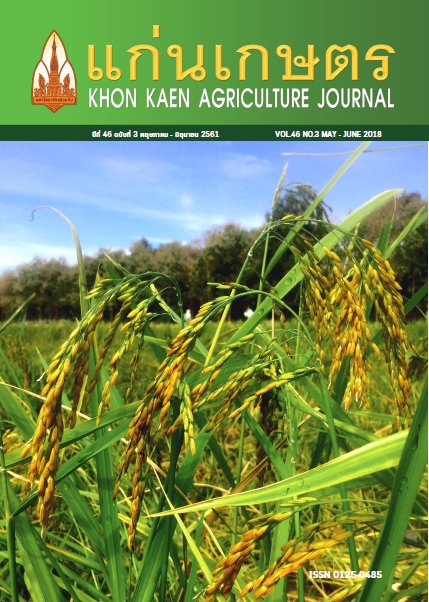ตำแหน่งของอินทรีย์คาร์บอนและคาร์บอนที่เสถียรในดินนาที่มีเนื้อดินต่างกัน
Main Article Content
บทคัดย่อ
งานวิจัยนี้มีวัตถุประสงค์เพื่อหาตำแหน่งของอินทรีย์คาร์บอนและคาร์บอนที่เสถียรที่ใช้ตัวชี ้วัดที่เหมาะสมกับเม็ดดินกลุ่มขนาดต่างๆ ของดินนาสองเนื้อดิน ดินร่วน (ชุดดินราชบุรี) และดินร่วนปนทราย (ชุดดินอุบล) ทำการศึกษาแยกกลุ่มขนาดเม็ดดิน ได้แก่ 4-2 mm (LMa), 2-1 mm (MMa), 1-0.25 mm (SMa), 0.25-0.053 mm (Mi) และ <0.053 mm (FMi) และหาปริมาณอินทรีย์คาร์บอนในดิน (SOC), อินทรีย์คาร์บอนที่ย่อยสลายง่าย (LOC) และค่าตัวชี้วัดสัดส่วนคาร์บอนที่เสถียร (non LOC:SOC) ผลการศึกษาพบว่าปริมาณ SOC ของดินร่วนมีค่า 1.073-1.557 เปอร์เซ็นต์ ของดินร่วนปนทรายมีค่า 0.377-0.823 เปอร์เซ็นต์ ปริมาณ LOC ของดินร่วนมีค่า 0.721-0.885 มก./กก. ของดินร่วนปนทรายมีค่า 0.603-0.806 มก./กก. ในขณะที่ค่าสัดส่วน non LOC:SOC ของดินร่วนมีค่า 0.909-0.954 และของดินร่วนปนทรายมีค่า 0.811-0.925 ในกรณีของเม็ดดินค่าเฉลี่ยปริมาณ SOC จากทั้งสองเนื้อดินพบว่าเม็ดดินขนาด FMi มีค่าเฉลี่ยมากที่สุด 1.188 เปอร์เซ็นต์ ในขณะที่เม็ดขนาด LMa มีค่าเฉลี่ยปริมาณ SOC ต่ำที่สุด 0.92 เปอร์เซ็นต์ ส่วนปริมาณ LOC ของทั้งสองเนื้อดินนั้นของเม็ดดินขนาด LMa มีค่ามากที่สุด 0.798 มก./กก. และเม็ดดินขนาด Mi มีปริมาณ LOC น้อยที่สุด 0.641 มก./กก. ในขณะที่ค่าสัดส่วนของ non LOC:SOC ที่แสดงปริมาณอินทรีย์คาร์บอนที่เสถียรของเม็ดดินขนาด Mi มีค่า 0.935 ซึ่งมากกว่าของเม็ดดินขนาด LMa 0.875 ทำให้สรุปได้ว่าทั้งสองเนื้อดินเม็ดดินขนาด Mi มีความเสถียรมากกว่าเม็ดดินขนาด LMa ด้วยกลไก clay–P– non LOC, clay–P–SOC, clay–P–LOC และ clay–P–clay งานวิจัยนี้ยังได้แสดงให้เห็นว่าสัดส่วนของ non LOC:SOC เป็นตัวชี้วัดหนึ่งที่สำคัญที่บ่งบอกถึงความเสถียรของอินทรีย์คาร์บอนในเม็ดดิน และยังเผยให้เห็นปริมาณ non LOC ว่าเป็นองค์ประกอบส่วนใหญ่ของ SOC มากกว่า LOC ในเม็ดดินทุกขนาด
Article Details
เอกสารอ้างอิง
Baver, L.D., W.H. Gardner, and W.R. Gardner. 1972. Soil Physics. 4th Edition. John Wiley and Sons, New York.
Bronick, C.J., and R. Lal. 2005. Soil structure and management: A review. Geoderma. 124: 3–22.
Demirel, B., and P. Scherer. 2008. The roles of acetotrophic and hydrogenotrophic methanogens during anaerobic conversion of biomass to methane: A review. Reviews in Environmental Science and Biotechnology. 7: 173-190.
Fernandez, R., A. Quiroga, C. Zorati, and E. Noellemeyer. 2010. Carbon contents and respiration rates of aggregate size fractions under no-till and conventional tillage. Soil & Tillage Research. 109: 103–109.
Helgason, B.L., F.L. Walley, and J.J. Germida. 2010. No-till soil management increases microbial biomass and alters community profiles in soil aggregates. Applied Soil Ecology. 46: 390–397.
Hobley, E. U., J. Baldock, and B. Wilson. 2016. Environmental and human influences on organic carbon fractions down the soil profile. Agriculture, Ecosystems & Environment. 223: 152-166.
Luo, L., H. Lin, and S. Li. 2010. Quantification of 3-D soil macropore networks in different soil types and land uses using computed tomography. Journal of Hydrology. 393: 53–64.
Marland, G., C.T. Garten Jr., W.M. Post, and T.O. West. 2004. Studies on enhancing carbon sequestration in soils. Energy. 29: 1643–1650.
Mangalassery, S., S. Sjogersten, D.L. Sparkes, C. J. Sturrock, and S.J. Mooney. 2013. The effect of soil aggregate size on pore structure and its consequence on emission of greenhouse gases. Soil & Tillage Research. 132: 39–46.
Mc Lean, E.O. 1982. Soil pH and lime requirement. In: A. L. Page Edition. Methods of Soil Analysis, Part II. Chemical and Microbiological Properties. Soil Science Society of America, Madison, WI. pp. 199-224.
Moody, P.W., and P.T. Cong. 2008. Soil constraints and management package (SCAMP): guidelines for sustainable management of tropical upland soil. ACIAR Monograph No. 130, Australian center for international agricultural research, Canberra.
Plante, A.F., R.T. Conant, C.E. Stewart, K. Paustian, and J. Six. 2006. Impact of soil texture on the distribution of soil organic matter in physical and chemical fractions. Soil Science Society of America Journal. 70: 287–296.
Puttaso, A., P. Vityakon, F. Rasche, P. Saenjan, V. Treloges, and G, Cadisch. 2013. Does Organic Residue Quality Influence Carbon Retention in a Tropical Sandy Soil?. Soil Science Society of America Journal. 77: 1001-1011.
Tisdall, J.M., and J.M. Oades. 1982. Organic matter and water-stable aggregates in soils. Journal Soil Science. 33: 141–163.
Walkley, A., and I. A. Black. 1934. An examination of the degtjareff method for determining soil organic matter and a proposed modification of the chromic acid titration method. Soil Science. 37: 29-33.
Udawatta, R.P., and S.H. Anderson. 2008. CT-measured pore characteristics of surface and subsurface soils influenced by agroforestry and grass buffers. Geoderma. 145: 381–389.
Yang, X., J. Meng, Y. Lan, W. Chen, T. Yang, J. Yuan, S. Liu, and J. Han. 2017. Effects of maize stover and its biochar on soil CO2 emissions and labile organic carbon fractions in Northeast China. Agriculture, Ecosystems & Environment. 240: 24-31.


